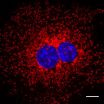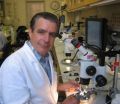(Press-News.org) Everyone knows that exercise comes with metabolic and cardiovascular benefits, but scientists understand surprisingly little about how physical activity influences the heart itself. Now, a new study in the December 23rd issue of Cell, a Cell Press publication, offers some of the first molecular-level insights.
The studies in mice suggest that exercise turns on a genetic program that leads the heart to grow as heart muscle cells divide. It appears that shift in activity is driven in part by a single transcription factor (a gene that controls other genes). That gene, known as C/EBPb, was known to play important roles in other parts of the body, but this is the first evidence for its influence in the heart.
"We've identified a pathway involved in beneficial cardiac hypertrophy – the good kind of heart growth," said Bruce Spiegelman of Harvard Medical School.
The findings may have clinical implications, particularly for those with heart failure or other conditions that make exercise difficult to impossible, the researchers say.
"This is yet another reason to keep on exercising," said Anthony Rosenzweig of Harvard Medical School. "In the longer term, by understanding the pathways that benefit the heart with exercise, we may be able to exploit those for patients who aren't able to exercise. If there were a way to modulate the same pathway in a beneficial way, it would open up new avenues for treatment."
There may also be ways to optimize training regimens such that they tap into this natural mechanism more efficiently, Spiegelman added.
Researchers had known that heart muscle adapts to increased pressure and volume by increasing in size. That's true in the case of exercise as it is in pathological conditions including high blood pressure. In disease states as opposed to exercise, those changes to the heart can ultimately lead to heart failure and arrhythmias.
In the new study, the researchers sought to better understand those differences
using methods developed in the Spiegelman lab that allowed them to quantify changes in the expression of transcription factors in the heart at the genome-wide level in both exercised mice and those who had their aortas surgically constricted, a treatment that leads to a pathological increase in heart size.
The researchers found changes in 175 transcription factors in exercised mice and 96 in mice whose aortas were constricted. Importantly, the changes showed little overlap between the two animal models. For instance, the researchers said, 13 percent of the genes with differential expression following exercise have known or suggested roles in cell proliferation compared to less than one percent of those that changed with the surgery.
The researchers then zeroed in on one transcription factor, C/EBPb, which goes down about two-fold with exercise and a second that rises in turn. Studies in animals and cell culture showed that the decline in C/EPBb leads to changes that appear to be consistent with those that follow endurance exercise, including an increase in heart muscle size and proliferation. Those mice with lower C/EPBb levels also were resistant to heart failure.
That finding is key given that there is little prior evidence showing that the increase in heart size with exercise has direct benefits, the researchers say. The new evidence also gives important biological insights into the heart's potential for regeneration of muscle.
Rosenzweig said it will be important in future studies to explore all of the players in the pathway and to provide even more definitive evidence that exercise leads to an increased rate of cell proliferation in heart muscle.
###
Want more research news from Cell Press? Go to:
http://www.eurekalert.org/jrnls/cell/pages/index.php
END
We aren't just what we eat; we are what our parents ate too. That's an emerging idea that is bolstered by a new study showing that mice sired by fathers fed on a low-protein diet show distinct and reproducible changes in the activity of key metabolic genes in their livers. Those changes occurred despite the fact that the fathers never saw their offspring and spent minimal time with their mothers, the researchers say, suggesting that the nutritional information is passed on to the next generation via the sperm not through some sort of social influence.
The new findings ...
LA JOLLA, Calif., December 23, 2010 – Melanoma is one of the least common types of skin cancer, but it is also the most deadly. Melanocytes (pigment-producing skin cells) lose the genetic regulatory mechanisms that normally limit their number, allowing them to divide and proliferate out of control. One such regulator, called MITF, controls an array of genes that influence melanocyte development, function and survival. Researchers at Sanford-Burnham Medical Research Institute (Sanford-Burnham) and their collaborators recently used a melanoma mouse model, cell cultures and ...
Tomato plants use similar biochemical mechanisms to reject pollen from their own flowers as well as pollen from foreign but related plant species, thus guarding against both inbreeding and cross-species hybridization, report plant scientists at the University of California, Davis.
The researchers identified a tomato pollen gene that encodes a protein that is very similar to a protein thought to function in preventing self-pollination in petunias. The tomato gene also was shown to play a role in blocking cross-species fertilization, suggesting that similar biochemical ...
BOSTON--By tweaking a single gene, scientists have mimicked in sedentary mice the heart-strengthening effects of two weeks of endurance training, according to a report from Dana-Farber Cancer Institute and Beth Israel Deaconess Medical Center (BIDMC).
The genetic manipulation spurred the animals' heart muscle cells -- called cardiomyocytes -- to proliferate and grow larger by an amount comparable to normal mice that swam for up to three hours a day, the authors write in the journal Cell.
This specific gene manipulation can't be done in humans, they say, but the findings ...
Use of electronic health records by hospitals across the United States has had only a limited effect on improving the quality of medical care, according to a new RAND Corporation study.
Studying a wide mix of hospitals nationally, researchers found that hospitals with basic electronic health records demonstrated a significantly higher increase in quality of care for patients being treated for heart failure.
However, similar gains were not noted among hospitals that upgraded to advanced electronic health records, and hospitals with electronic health records did not ...
LA JOLLA, CA—Researchers at the Salk Institute for Biological Studies have discovered how AMPK, a metabolic master switch that springs into gear when cells run low on energy, revs up a cellular recycling program to free up essential molecular building blocks in times of need.
In a paper published in the Dec. 23, 2010 edition of Science Express, a team led by Reuben Shaw, PhD., Howard Hughes Medical Institute Early Career Scientist and Hearst Endowment assistant professor in the Salk's Molecular and Cell Biology Laboratory, reports that AMPK activates a cellular recycling ...
Phosphorous levels plummet in kidney disease patients who stick to a vegetarian diet, according to a study appearing in an upcoming issue of the Clinical Journal of the American Society Nephrology (CJASN). The results suggest that eating vegetables rather than meat can help kidney disease patients avoid accumulating toxic levels of this mineral in their bodies.
Individuals with kidney disease cannot adequately rid the body of phosphorus, which is found in dietary proteins and is a common food additive. Kidney disease patients must limit their phosphorous intake, as high ...
WORCESTER, Mass. — Scientists at the University of Massachusetts Medical School and the University of Texas at Austin have uncovered evidence that environmental influences experienced by a father can be passed down to the next generation, "reprogramming" how genes function in offspring. A new study published this week in Cell shows that environmental cues—in this case, diet—influence genes in mammals from one generation to the next, evidence that until now has been sparse. These insights, coupled with previous human epidemiological studies, suggest that paternal environmental ...
The cell signaling pathway known as Wnt, commonly activated in cancers, causes internal membranes within a healthy cell to imprison an enzyme that is vital in degrading proteins, preventing the enzyme from doing its job and affecting the stability of many proteins within the cell, researchers at UCLA's Jonsson Comprehensive Cancer Center have found.
The finding is important because sequestering the enzyme, Glycogen Synthase Kinase 3 (GSK3), results in the stabilization of proteins in the cell, at least one of which is known to be a key player in cancer, said Dr. Edward ...
FINDINGS: Whitehead Institute researchers have determined that heat shock protein 90 (Hsp90) can create diverse heritable traits in brewer's yeast (Saccharomyces cerevisiae) by affecting a large portion of the yeast genome. The finding has led the researchers to conclude that Hsp90 has played a key role in shaping the evolutionary history of the yeast genome, and likely others as well.
RELEVANCE: Over the past several years, Whitehead Member Susan Lindquist has built the case that heat shock proteins (Hsps), which are found across species from bacteria to humans, are ...

